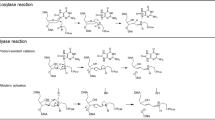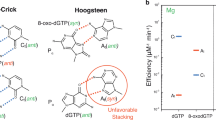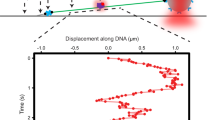Abstract
O6-alkylguanine-DNA alkyltransferase (AGT), or O6-methylguanine-DNA methyltransferase (MGMT), prevents mutations and apoptosis resulting from alkylation damage to guanines. AGT irreversibly transfers the alkyl lesion to an active site cysteine in a stoichiometric, direct damage reversal pathway. AGT expression therefore elicits tumor resistance to alkylating chemotherapies, and AGT inhibitors are in clinical trials. We report here structures of human AGT in complex with double-stranded DNA containing the biological substrate O6-methylguanine or crosslinked to the mechanistic inhibitor N1,O6-ethanoxanthosine. The prototypical DNA major groove–binding helix-turn-helix (HTH) motif mediates unprecedented minor groove DNA binding. This binding architecture has advantages for DNA repair and nucleotide flipping, and provides a paradigm for HTH interactions in sequence-independent DNA-binding proteins like RecQ and BRCA2. Structural and biochemical results further support an unpredicted role for Tyr114 in nucleotide flipping through phosphate rotation and an efficient kinetic mechanism for locating alkylated bases.
This is a preview of subscription content, access via your institution
Access options
Subscribe to this journal
Receive 12 print issues and online access
$209.00 per year
only $17.42 per issue
Buy this article
- Purchase on SpringerLink
- Instant access to full article PDF
Prices may be subject to local taxes which are calculated during checkout






Similar content being viewed by others
References
Lindahl, T. & Wood, R.D. Quality control by DNA repair. Science 286, 1897–1905 (1999).
Trewick, S.C., Henshaw, T.F., Hausinger, R.P., Lindahl, T. & Sedgwick, B. Oxidative demethylation by Escherichia coli AlkB directly reverts DNA base damage. Nature 419, 174–178 (2002).
Falnes, P.O., Johansen, R.F. & Seeberg, E. AlkB-mediated oxidative demethylation reverses DNA damage in Escherichia coli. Nature 419, 178–182 (2002).
Aas, P.A. et al. Human and bacterial oxidative demethylases repair alkylation damage in both RNA and DNA. Nature 421, 859–863 (2003).
Meikrantz, W., Bergom, M.A., Memisoglu, A. & Samson, L. O6-alkylguanine DNA lesions trigger apoptosis. Carcinogenesis 19, 369–372 (1998).
Hickman, M.J. & Samson, L.D. Apoptotic signaling in response to a single type of DNA lesion, O6-methylguanine. Mol. Cell 14, 105–116 (2004).
Mitra, S. & Kaina, B. Regulation of repair of alkylation damage in mammalian genomes. Prog. Nucleic Acid Res. Mol. Biol. 44, 109–142 (1993).
Gerson, S.L. Clinical relevance of MGMT in the treatment of cancer. J. Clin. Oncol. 20, 2388–2399 (2002).
Noll, D.M. & Clarke, N.D. Covalent capture of a human O6-alkylguanine alkyltransferase–DNA complex using N1,O6-ethanoxanthosine, a mechanism-based crosslinker. Nucleic Acids Res. 29, 4025–4034 (2001).
Wibley, J.E., Pegg, A.E. & Moody, P.C. Crystal structure of the human O6-alkylguanine-DNA alkyltransferase. Nucleic Acids Res. 28, 393–401 (2000).
Daniels, D.S. & Tainer, J.A. Conserved structural motifs governing the stoichiometric repair of alkylated DNA by O6-alkylguanine-DNA alkyltransferase. Mutat. Res. 460, 151–163 (2000).
Daniels, D.S. et al. Active and alkylated human AGT structures: a novel zinc site, inhibitor and extrahelical base binding. EMBO J. 19, 1719–1730 (2000).
Vora, R.A., Pegg, A.E. & Ealick, S.E. A new model for how O6-methylguanine-DNA methyltransferase binds DNA. Proteins 32, 3–6 (1998).
Goodtzova, K., Kanugula, S., Edara, S. & Pegg, A.E. Investigation of the role of tyrosine-114 in the activity of human O6-alkylguanine-DNA alkyltransferase. Biochemistry 37, 12489–12495 (1998).
Pegg, A.E., Morimoto, K. & Dolan, M.E. Investigation of the specificity of O6-alkylguanine-DNA-alkyltransferase. Chem. Biol. Interact. 65, 275–281 (1988).
Rasimas, J.J., Pegg, A.E. & Fried, M.G. DNA-binding mechanism of O6-alkylguanine-DNA alkyltransferase. Effects of protein and DNA alkylation on complex stability. J. Biol. Chem. 278, 7973–7980 (2003).
Glassner, B.J., Rasmussen, L.J., Najarian, M.T., Posnick, L.M. & Samson, L.D. Generation of a strong mutator phenotype in yeast by imbalanced base excision repair. Proc. Natl. Acad. Sci. U. S. A. 95, 9997–10002 (1998).
Frosina, G. Overexpression of enzymes that repair endogenous damage to DNA. Eur. J. Biochem. 267, 2135–2149 (2000).
Dodson, G. & Wlodawer, A. Catalytic triads and their relatives. Trends Biochem. Sci. 23, 347–352 (1998).
Guengerich, F.P., Fang, Q., Liu, L., Hachey, D.L. & Pegg, A.E. O6-alkylguanine-DNA alkyltransferase: low pKa and high reactivity of cysteine 145. Biochemistry 42, 10965–10970 (2003).
Luu, K.X., Kanugula, S., Pegg, A.E., Pauly, G.T. & Moschel, R.C. Repair of oligodeoxyribonucleotides by O6-alkylguanine-DNA alkyltransferase. Biochemistry 41, 8689–8697 (2002).
Moody, P.C. & Demple, B. Crystallization of O6-methylguanine-DNA methyltransferase from Escherichia coli. J. Mol. Biol. 200, 751–752 (1988).
von Hippel, P.H. & Berg, O.G. Facilitated target location in biological systems. J. Biol. Chem. 264, 675–678 (1989).
Stanford, N.P., Szczelkun, M.D., Marko, J.F. & Halford, S.E. One- and three-dimensional pathways for proteins to reach specific DNA sites. EMBO J. 19, 6546–6557 (2000).
Ali, R.B. et al. Implication of localization of human DNA repair enzyme O6-methylguanine-DNA methyltransferase at active transcription sites in transcription-repair coupling of the mutagenic O6-methylguanine lesion. Mol. Cell. Biol. 18, 1660–1669 (1998).
Banavali, N.K. & MacKerell, A.D. Jr. Free energy and structural pathways of base flipping in a DNA GCGC containing sequence. J. Mol. Biol. 319, 141–160 (2002).
Huang, N., Banavali, N.K. & MacKerell, A.D. Jr. Protein-facilitated base flipping in DNA by cytosine-5-methyltransferase. Proc. Natl. Acad. Sci. USA 100, 68–73 (2003).
Hollis, T., Ichikawa, Y. & Ellenberger, T. DNA bending and a flip-out mechanism for base excision by the helix-hairpin-helix DNA glycosylase, Escherichia coli AlkA. EMBO J. 19, 758–766 (2000).
Bruner, S.D., Norman, D.P. & Verdine, G.L. Structural basis for recognition and repair of the endogenous mutagen 8-oxoguanine in DNA. Nature 403, 859–866 (2000).
Barrett, T.E. et al. Crystal structure of a G:T/U mismatch-specific DNA glycosylase: mismatch recognition by complementary-strand interactions. Cell 92, 117–129 (1998).
Parikh, S.S. et al. Base excision repair initiation revealed by crystal structures and binding kinetics of human uracil-DNA glycosylase with DNA. EMBO J. 17, 5214–5226 (1998).
Mol, C.D., Izumi, T., Mitra, S. & Tainer, J.A. DNA-bound structures and mutants reveal abasic DNA binding by APE1 and DNA repair coordination [corrected]. Nature 403, 451–456 (2000).
Hosfield, D.J., Guan, Y., Haas, B.J., Cunningham, R.P. & Tainer, J.A. Structure of the DNA repair enzyme endonuclease IV and its DNA complex: double-nucleotide flipping at abasic sites and three-metal-ion catalysis. Cell 98, 397–408 (1999).
Klimasauskas, S., Kumar, S., Roberts, R.J. & Cheng, X. HhaI methyltransferase flips its target base out of the DNA helix. Cell 76, 357–369 (1994).
Moschel, R.C., McDougall, M.G., Dolan, M.E., Stine, L. & Pegg, A.E. Structural features of substituted purine derivatives compatible with depletion of human O6-alkylguanine-DNA alkyltransferase. J. Med. Chem. 35, 4486–4491 (1992).
Gajiwala, K.S. & Burley, S.K. Winged helix proteins. Curr. Opin. Struct. Biol. 10, 110–116 (2000).
Gajiwala, K.S. et al. Structure of the winged-helix protein hRFX1 reveals a new mode of DNA binding. Nature 403, 916–921 (2000).
Luscombe, N.M., Austin, S.E., Berman, H.M. & Thornton, J.M. An overview of the structures of protein–DNA complexes. Genome Biol. 1, reviews001.1–001.37 (2000).
Yang, H. et al. BRCA2 function in DNA binding and recombination from a BRCA2-DSS1-ssDNA structure. Science 297, 1837–1848 (2002).
Sibanda, B.L. et al. Crystal structure of an Xrcc4–DNA ligase IV complex. Nat. Struct. Biol. 8, 1015–1019 (2001).
Bernstein, D.A., Zittel, M.C. & Keck, J.L. High-resolution structure of the E. coli RecQ helicase catalytic core. EMBO J. 22, 4910–4921 (2003).
Leslie, A.G.W. Joint CCP4 + ESF-EAMCB Newsletter on Protein Crystallography Vol. 26 (Daresbury Laboratory, Warrington, UK, 1992).
Collaborative Computational Project Number 4. The CCP4 suite, programs for protein crystallography. Acta Crystallogr. D 50, 760–763 (1994).
Holton, J. & Alber, T. Automated protein crystal structure determination using ELVES. Proc. Natl. Acad. Sci. USA 101, 1537–1542 (2004).
Navaza, J. AMoRe: an automated package for molecular replacement. Acta Crystallogr. A. 50, 157–163 (1994).
McRee, D.E. XtalView/Xfit—a versatile program for manipulating atomic coordinates and electron density. J. Struct. Biol. 125, 156–165 (1999).
Brunger, A.T. et al. Crystallography & NMR system: a new software suite for macromolecular structure determination. Acta Crystallogr. D 54, 905–921 (1998).
Lavery, R. & Sklenar, H. The definition of generalized helicoidal parameters and of axis curvature for irregular nucleic acids. J. Biomol. Struct. Dyn. 6, 63–91 (1988).
Acknowledgements
We thank C.L. Brooks III, M.E. Stroupe and A.J. Das for critical discussion and the staff and facilities of the Stanford Synchrotron Radiation Laboratory. This work was supported by grants from the US National Institutes of Health (J.A.T.), US National Cancer Institute (A.E.P.), Patterson Trust (D.M.N.), Alexander and Margaret Stewart Trust (D.M.N.) and Skaggs Institute for Chemical Biology (D.S.D.).
Author information
Authors and Affiliations
Corresponding author
Ethics declarations
Competing interests
The authors declare no competing financial interests.
Rights and permissions
About this article
Cite this article
Daniels, D., Woo, T., Luu, K. et al. DNA binding and nucleotide flipping by the human DNA repair protein AGT. Nat Struct Mol Biol 11, 714–720 (2004). https://doi.org/10.1038/nsmb791
Received:
Accepted:
Published:
Issue Date:
DOI: https://doi.org/10.1038/nsmb791



